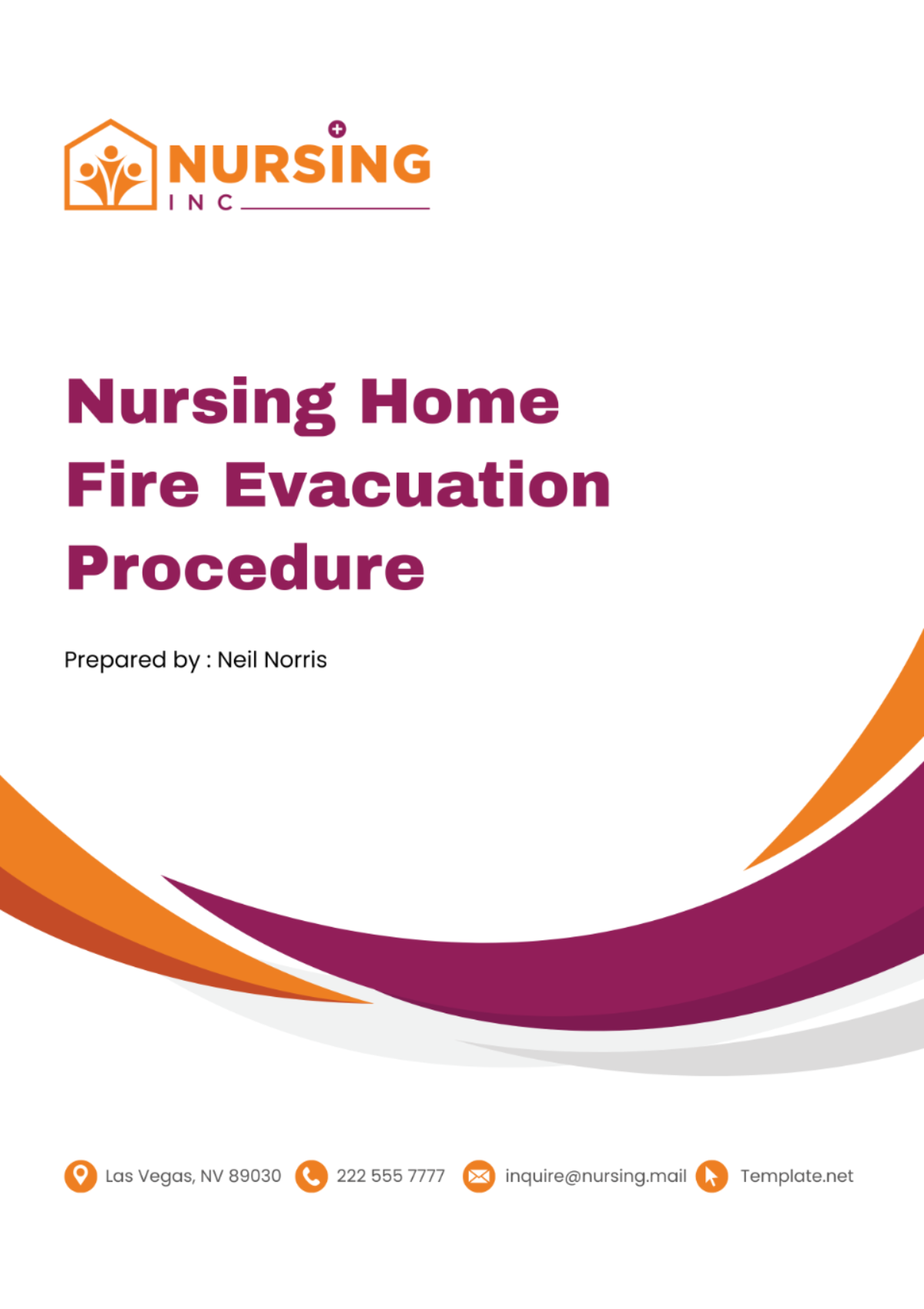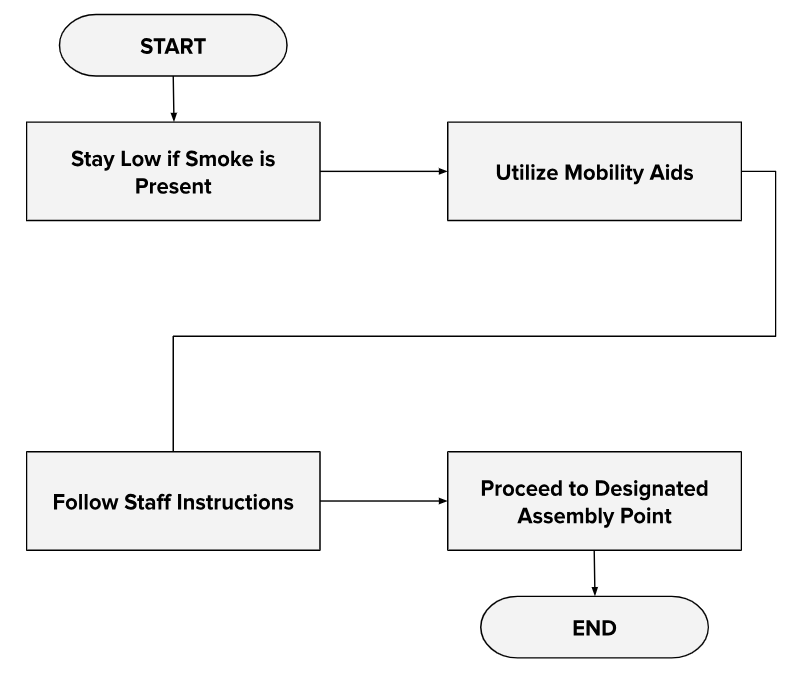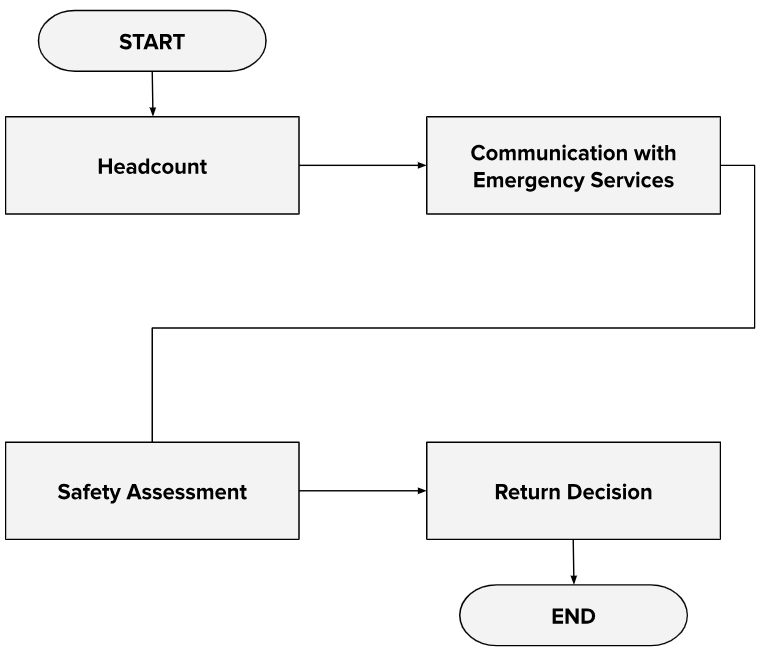Free Nursing Home Fire Evacuation Procedure

A. Introduction
Welcome to the Nursing Home Fire Evacuation Procedure. This comprehensive plan is designed to safeguard the lives and well-being of our residents by providing clear guidance for the swift, secure, and organized evacuation during fire emergencies within our facility. As caregivers entrusted with the safety and care of our residents, it is our utmost priority to ensure their protection and security in any unforeseen circumstances.
In compliance with US laws and standards governing nursing home safety, this procedure outlines the steps to be taken in the event of a fire emergency, aiming to minimize risks and maximize efficiency in evacuating residents to safety. Through thorough planning, regular training, and continuous improvement, we strive to create a safe environment where residents, staff, and visitors can feel confident in our ability to respond effectively to emergencies. By familiarizing yourself with this procedure and participating in regular drills, you play a crucial role in maintaining the safety and well-being of our community.
B. Scope
The Nursing Home Fire Evacuation Procedure applies to every individual present within our facility during a fire emergency, encompassing all staff, residents, and visitors. Regardless of role or status, everyone is subject to the protocols outlined herein, underscoring our commitment to ensuring the safety and well-being of all occupants.
In adherence to US regulations and industry standards governing nursing home safety, this procedure sets forth clear guidelines and responsibilities for each individual involved in the evacuation process. Whether you are a dedicated caregiver, a cherished resident, or a valued visitor, your cooperation and adherence to these protocols are essential for a coordinated and effective response to fire emergencies. Together, we cultivate a culture of preparedness and resilience, fostering an environment where every member of our community feels secure and supported during challenging times.
C. Emergency Notification and Activation
In the event of a fire emergency, prompt and decisive action is crucial to ensure the safety of all individuals within the nursing home. The Emergency Notification and Activation section outlines the procedures for detecting fires, activating alarms, and notifying designated personnel to initiate an effective response.
1. Fire Detection
a. Manual Detection: If a staff member observes a fire or smoke, they must immediately raise the alarm by activating the nearest fire alarm pull station.
b. Automatic Detection: In areas equipped with automated fire detection systems, such as smoke detectors or heat sensors, any activation of these devices should be treated as a confirmed fire.
2. Alarm Activation
a. Responsibility: The staff member who discovers the fire is responsible for activating the fire alarm system.
b. Location of Pull Stations: Familiarize yourself with the location of fire alarm pull stations throughout the facility to ensure prompt activation in case of emergency.
3. Emergency Coordinator Notification
a. Primary Coordinator: Upon activating the fire alarm, the staff member must immediately notify the designated emergency coordinator or their backup.
b. Backup Coordinator: In the absence of the primary coordinator, the next available staff member with emergency response training assumes the role of coordinator.
4. Communication Protocol
a. Clear Communication: When reporting the fire, provide precise details regarding its location, size, and any hazards present to facilitate an effective response.
b. Use of Intercom or Communication Devices: In larger facilities, utilize intercom systems or other communication devices to relay information quickly to all staff members.
5. Evacuation Signal
a. Distinct Signal: The fire alarm system emits a distinct signal to indicate the need for evacuation. Familiarize yourself with this signal to differentiate it from other alarms.
6. Verification
a. Confirming Alarm Activation: Upon hearing the fire alarm, all staff members should visually verify the presence of smoke or fire in their area before taking action.
7. Reporting to Emergency Services
a. Dialing Emergency Services: If the fire is confirmed and evacuation is necessary, designated staff members should promptly dial emergency services (e.g., 911) to report the incident and request assistance.
D. Evacuation Routes and Assembly Points
In the event of a fire emergency, clear evacuation routes and designated assembly points are crucial for ensuring the safe evacuation of residents and staff. The Evacuation Routes and Assembly Points section outlines the procedures for identifying and utilizing these vital resources.
1. Evacuation Routes
a. Clear Markings: All building exits are clearly marked with illuminated exit signs and directional arrows to guide individuals to safety.
b. Posted Evacuation Plans: Throughout the facility, detailed evacuation plans are prominently displayed, indicating the shortest route to the nearest exit from any location within the building.
2. Assembly Points
a. Safe Distance: Assembly points are strategically located at safe distances outside the building to prevent congestion and ensure the safety of evacuees.
b. Designated Locations: Each assembly point is clearly identified with signage and communicated to all staff members and residents during orientation and training sessions.
3. Accessibility Considerations
a. Accessible Routes: Evacuation routes are designed to accommodate individuals with mobility impairments, utilizing ramps, elevators, and designated assistance areas.
b. Assistance Provided: Staff members are trained to assist residents with mobility challenges during evacuation, ensuring no one is left behind.
4. Alternate Routes
a. Secondary Exits: In addition to primary evacuation routes, alternate exits are identified and accessible for use in the event primary routes are blocked or compromised.
b. Staff Familiarity: All staff members are familiarized with alternate evacuation routes through regular training and drills to ensure readiness for any scenario.
E. Staff Responsibilities and Training
Ensuring the safety and well-being of residents during fire emergencies requires well-trained and prepared staff members. The Staff Responsibilities and Training section outlines the specific duties assigned to staff members and the training they receive to effectively respond to fire emergencies.
Training Topic | Frequency | Training Provider |
|---|---|---|
Emergency Evacuation Procedures | Bi-annual | In-house Training Staff |
Operation of Firefighting Equipment | Annual | Certified Fire Safety Instructor |
First Aid | Bi-annual | Certified First Aid Trainer |
Managing Headcount at Assembly Points | Quarterly | Emergency Preparedness Coordinator |
F. Resident Evacuation Procedures
During fire emergencies, the safety and well-being of residents are paramount. The Resident Evacuation Procedures section outlines the steps residents should follow to ensure their safe evacuation from the facility. By familiarizing themselves with these procedures, residents can take an active role in their own safety and contribute to a smooth evacuation process.

Stay Low if Smoke is Present: Residents are advised to stay close to the ground to minimize exposure to smoke, which can impair visibility and breathing.
Utilize Mobility Aids: Residents who require assistance with mobility are encouraged to utilize available aids, such as wheelchairs or walking aids, to facilitate their evacuation.
Follow Staff Instructions: Residents should listen carefully to instructions provided by staff members and follow them promptly and calmly during the evacuation process.
Proceed to Designated Assembly Point: Once evacuated, residents should proceed directly to the designated assembly point outside the building and await further instructions from staff or emergency responders.
G. Special Considerations for Vulnerable Residents
In the event of a fire emergency, it is imperative to address the unique needs of residents who may require additional assistance due to physical or cognitive limitations. The Special Considerations for Vulnerable Residents section outlines the specialized procedures and support available for evacuating residents who are bedridden, wheelchair-bound, or have cognitive impairments.
1. Bedridden Residents
a. Pre-Identified Evacuation Plans: Each bedridden resident has a pre-identified evacuation plan tailored to their specific needs and location within the facility.
b. Priority Assistance: Trained staff members are assigned to assist bedridden residents during the evacuation process, ensuring their safe and swift removal from the premises.
2. Wheelchair-Bound Residents
a. Accessible Evacuation Routes: Evacuation routes are designed to accommodate wheelchair-bound residents, with accessible ramps and designated assistance areas.
b. Assistance Provided: Trained staff members are equipped to assist wheelchair-bound residents with navigating evacuation routes and accessing evacuation aids as needed.
3. Residents with Cognitive Impairments
a. Clear and Simple Instructions: Staff members communicate evacuation instructions to residents with cognitive impairments using clear and simple language, repeated as necessary for understanding.
b. Assistance and Reassurance: Trained staff members provide ongoing assistance and reassurance to residents with cognitive impairments, guiding them through the evacuation process with patience and empathy.
4. Ongoing Training and Preparedness
a. Regular Drills and Training: Staff members receive regular training and participate in drills focused on evacuating vulnerable residents, ensuring readiness and familiarity with evacuation procedures.
b. Review and Improvement: Evacuation procedures for vulnerable residents are regularly reviewed and updated based on feedback and lessons learned from drills and real-life incidents.
H. Equipment and Resources
The availability and proper maintenance of firefighting equipment and resources are essential components of our preparedness for fire emergencies. The Equipment and Resources section details the various tools and devices accessible within the facility to support the safe evacuation of residents and the effective management of fire incidents.
Equipment/Resources | Description | Maintenance Schedule |
|---|---|---|
Fire Extinguishers | Strategically placed throughout the facility for quick access in case of small fires. | Monthly inspections by certified technicians to ensure proper functionality. |
Evacuation Chairs | Used to assist individuals with mobility impairments in safely descending stairs during evacuation. | Quarterly inspections and maintenance checks to ensure operational readiness. |
Emergency Lighting | Illuminates evacuation routes and assembly points during power outages or low visibility conditions. | Bi-annual testing and replacement of batteries to ensure continuous functionality. |
Communication Devices | Intercom systems or portable radios used for communication among staff members during emergencies. | Regular checks and battery replacements to ensure reliability during emergencies. |
I. Post-Evacuation Procedures and Communication
Following the successful evacuation of residents from the facility during a fire emergency, it is essential to implement thorough post-evacuation procedures to assess safety and coordinate with emergency services. The Post-Evacuation Procedures and Communication section outlines the steps taken to ensure the well-being of residents and determine when it is safe for them to return.

Headcount: Conduct a headcount to verify that all residents have been safely evacuated from the building.
Communication with Emergency Services: The emergency coordinator communicates with emergency services to report the incident and provide any necessary information.
Safety Assessment: Carry out an initial safety assessment of the building to determine the extent of damage and any potential hazards.
Return Decision: Based on the safety assessment, the emergency coordinator determines when it is safe for residents to return to the facility and communicates this decision to all relevant parties.
J. Additional Reminders and Tips
In addition to the detailed procedures outlined in this document, it is important to remember some key reminders and tips to enhance the effectiveness of our fire evacuation protocol. These reminders serve as valuable guidelines to ensure a smooth and safe evacuation process for all individuals within our facility:
Remain calm and focused during the evacuation.
Always prioritize the safety of residents and staff.
Communicate clearly and effectively.
Practice regular evacuation drills to ensure preparedness for an actual fire emergency.
In conclusion, the Nursing Home Fire Evacuation Procedure provides essential guidance for the swift, safe, and systematic evacuation of residents in the event of a fire emergency. By adhering to these procedures, remaining vigilant, and practicing regular drills, we uphold our commitment to ensuring the safety and well-being of all individuals within our care.
- 100% Customizable, free editor
- Access 1 Million+ Templates, photo’s & graphics
- Download or share as a template
- Click and replace photos, graphics, text, backgrounds
- Resize, crop, AI write & more
- Access advanced editor
Prioritize safety with the Nursing Home Fire Evacuation Procedure Template from Template.net. This editable and customizable template provides a step-by-step guide for safely evacuating residents and staff in the event of a fire, ensuring rapid response and minimal risk. Editable in our Ai Editor Tool, it's essential for preparedness, clear communication, and protecting the well-being of everyone in your nursing home during emergencies.





























